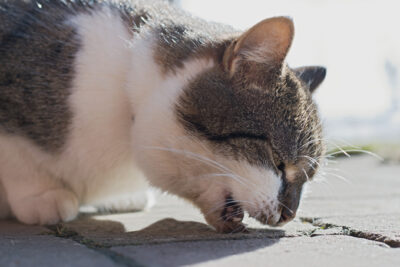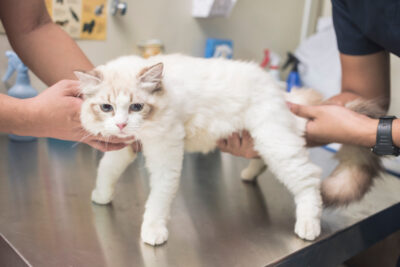Scabies in Cats

Overview
- Scabies is a skin condition caused in cats by an overgrowth of Notoedres cati mites.
- Cat scabies is highly contagious among cats exposed to an affected cat.
- Symptoms include itchiness, bumps, crusty skin, and hair loss.
- Treatment focuses on getting rid of mites with topical or oral medications.
Cat scabies is a skin disease caused by mites. It’s very common and affects cats all over the world. While highly contagious among cats, cat scabies is fortunately easy to diagnose and treat. If your cat is ever afflicted with this skin condition, your veterinarian will be an excellent resource to help you eradicate scabies in your cat.
What is Scabies?
Scabies is a catch-all term for the itchy skin disease caused by burrowing microscopic skin parasites called mites. Scabies can also be called sarcoptic mange. Dogs and cats are both susceptible to scabies. The parasite species that most often targets dogs (Sarcoptes scabei canis) is different from the species that tends to target cats (Notoedres cati). However, both species come from the same family of Sarcoptic mites.
In cats, Notoedres mites cause intense itching, hair loss, and redness. These mites are considered highly contagious — if one cat contracts scabies mites, usually all cats in the household are affected.
Unfortunately, Notoedres mites can pose a risk to other members of the household, too. Humans who come into close contact with a mite-infested cat can develop an itchy, bumpy rash, typically on their arms, chest, or belly. Humans that are bitten by Notoedres mites are not considered contagious, however. And human symptoms usually resolve once the cat is treated.
What Causes Scabies in Cats?

Scabies mites are transmitted from cat to cat when the cats are in direct contact with each other, and all cats in contact with Notoedres mites typically develop symptoms. Cats usually start to display symptoms of scabies a few weeks to a month after they become infested with mites. The mites cause itching and other skin problems when they burrow through the skin between hair follicles. Female mites lay 3-4 eggs per day in the burrows they create. The eggs hatch after 4-5 days, then the larvae crawl to the surface of the skin and dig their own burrow. The mites then molt, grow, dig more burrows in the skin, and become reproducing adults within 15 days.
Scabies is common in large feral cat populations. And while Notoedres mites only reproduce on cats, they have also been known to bite dogs, lynx, tigers, ocelots, foxes, rabbits, raccoons, coatis, bobcats, and humans.
Scabies mites are only considered contagious when they are on a cat because they die very quickly when deprived of their feline host. So there’s not much risk of environmental contamination since they can’t go from one host species to another, like some other parasites can.
However, a scabies mite could transfer from your cat to you accidentally and bite you before it dies. So, if your cat is infested, it is still a good idea to wash all their bedding and avoid handling them.
Symptoms of Scabies in Cats

Scabies is a very itchy, non-seasonal skin disease. After a cat has direct contact with another cat that has scabies mites, they may initially experience only mild itchiness. But, generally, itching becomes more intense the longer a cat is infested.
Cats that are infested for a long period of time develop hypersensitivity to the mites, which is what makes the itching worse. Some cats can become infected without developing itchy skin, but this is rare.
Additional signs of scabies in cats to look for include:
- Itching, crusting, and bumps that first appear along the margin of the ear and spread to the eyelids, face, and neck
- Itching, crusting, and bumps on the legs, feet, and perineum (spread through self-grooming)
- Intense scratching; some cats scratch themselves raw to relieve the itchiness of scabies
- Long-term mite infestations can lead to thickened, rough skin covered with gray-yellow crust
- Widespread hair loss
- Enlarged peripheral lymph nodes, as the cat’s immune system tries to fight off severe infestations
- Lethargy, weight loss, fever, and debilitation in severe cases
How to Diagnose Scabies and Mange in Cats
Fortunately, feline scabies is easy to diagnose and treat once your cat undergoes a veterinary examination. Your veterinarian will conduct a physical exam and most likely use a skin scraping to confirm the diagnosis. In this case, your veterinarian may collect a sample from the skin and put it under the microscope to confirm the presence of mites.
Some veterinarians may request a fecal sample, since cats often ingest mites while self-grooming, which then can be detected in their waste.
Cat Scabies and Mange Treatment

Notoedres mites, once diagnosed on a cat, are easy to treat, and there are several products available that can rid your cat of mites. It is important to treat your cat for scabies if they ever become infested, as the disease is highly contagious among cats, will usually get worse if untreated, and can cause serious pain and suffering in your cat.
Different treatment options that may be prescribed by veterinarians for cats with scabies include:
- Ivermectin injected under the skin every other week for two to three treatments
- Off-label use of selamectin (present in a product called Revolution) applied every two weeks for three applications
- Fipronil (present in several veterinarian-prescribed products, including Frontline Plus for cats)
- Imidacloprid/moxidectin (Advantage Multi)
- Lime sulfur rinses once a week for six to eight weeks (less commonly used because it’s very smelly, stains, and requires a cat to be shaved)
- Amitraz rinses weekly for three weeks (less commonly used due to negative side effects)
- For cats with secondary bacterial infections and intense itching, antibiotics and steroids or Apoquel may also be prescribed
All cats in the household, regardless of whether they are showing symptoms or not, should be treated for scabies mites.
General Cost of Scabies Treatment for Cats
The general cost of a veterinary appointment for scabies including a physical examination and skin scraping test can range from $75-$150. The general cost of treatment depends on which medication is prescribed and can range from $35-$150.
How to Prevent Scabies in Cats

The good news is that feline scabies can typically be prevented by simply using a monthly flea and tick prevention that also protects against mites. Several of the products listed above to treat mites, including Revolution, Advantage Multi, and Frontline for Cats, are also used for flea and tick prevention. So you can protect your cat against several parasites, including mites, with one product.
In addition to flea and tick prevention, one surefire way to protect your cat against mites is to keep your cat indoors only, or only let your cat outside while supervised or in an enclosure like a Catio. This ensures that your cat will not come into contact with any roaming cats that might be infested with scabies mites.
Related Conditions:
- Pyoderma
- Bacterial folliculitis
- Miliary dermatitis
This disease can also be confused with:
- Cutaneous adverse reactions to food (food allergies)
- Ringworm
- Demodex
- Malassezia dermatitis
- Chiggers (trombiculosis)
- Cheyletiellosis
- Otodectic dermatitis
- Autoimmune disorders (pemphigus)









